Latest News
July 17, 2008
By Susan Smith
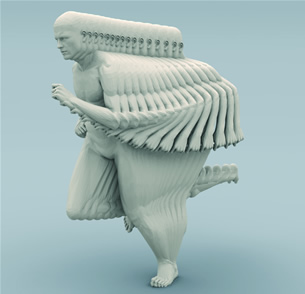
Artist and sculptor Peter Jansen of Nijmegen, the Netherlands has moved fluidly through passages of his life, from the study of physics and philosophy at university to guiding groups on survival and canoe trips, before settling on the arts. Jansen began sculpting about twenty years ago, and in earlier works he focused on creating open spaces almost free of matter and weight. Now, his sculptures capture in a freeze-frame the sequences of human movements in space and time, because he was fascinated with transposition and movement, most specifically, visualizing the space passed through by a human while in movement.
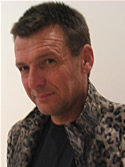 Peter Jansen |
“I was curious how the total shape of a human in motion in time would be,” he said. “What I found out and didn't realize in the beginning, is not all movements in real life are beautiful to look at, or produce sculptures that are nice to look at.”
Twenty years ago, computers were not capable of doing what they are today. When Jansen realized in recent years that he could develop his sculptures on a PC, he became very serious. “In fact, I went over from traditional craftsmanship to digital artist.”
Jansen learned that some software can do things other can't, so the files are going from the one software program to another, for one specific reason and then going to the next stage.
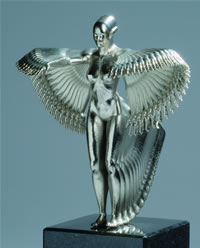 By finding a way to get very smooth .stl files that are not too large, Jansen was able to create his sculptures by building up layer by layer with a layer thickness of about 0,1 mm. He uses Materialise.MGX, a method employing 3D printing and rapid manufacturing techniques such as stereolithography and selective laser sintering. MGX operates both as a service bureau and as a brand collection of products.
By finding a way to get very smooth .stl files that are not too large, Jansen was able to create his sculptures by building up layer by layer with a layer thickness of about 0,1 mm. He uses Materialise.MGX, a method employing 3D printing and rapid manufacturing techniques such as stereolithography and selective laser sintering. MGX operates both as a service bureau and as a brand collection of products.
Some of Jansen’s sculptures are made of a polyamide powder whose particle sizes are in the order of magnitude of 50 µm. Additional powder layers are spread on top of one another. After deposition, in the SLS process, a computer controlled CO2 laser beam scans the surface and selectively binds together the powder particles of the corresponding cross section of the product. During laser exposure, the powder temperature rises above the glass transition point after which adjacent particles flow together. Another material used is alumide, a blend of aluminum and polyamide powders, which allows metallic-looking, non-porous components to be machined easily and is resistant to high temperatures.
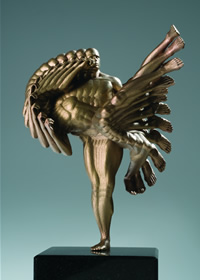 Jansen wants some of his sculptures to be at least as big as real humans or even bigger. He seeks companies who would like to own figures of this size and for good venues to display them. The sculptures Heel Daoyin, Runner and Thomas Flair were part of the Materialise.MGX exhibition in Milan’s Zona Tortona held in April.
Jansen wants some of his sculptures to be at least as big as real humans or even bigger. He seeks companies who would like to own figures of this size and for good venues to display them. The sculptures Heel Daoyin, Runner and Thomas Flair were part of the Materialise.MGX exhibition in Milan’s Zona Tortona held in April.
Some of Jansen’s sculptures are called “Strange Attractors.” For those sculptures, the calculated data from the Chaoscope freeware rendering software that runs on Windows makes a pointcloud. The pointcloud is triangulated into a mesh. Because of the self intersecting nature of strange attractor shapes, this mesh displays many defects which are repaired by manual reverse engineering.
When working on bronze casting, each object is printed with a support material by a 3D printer in a resin. “Due to the shape of most strange attractors it is impossible to work with a mold,” explained Jansen. After removing the 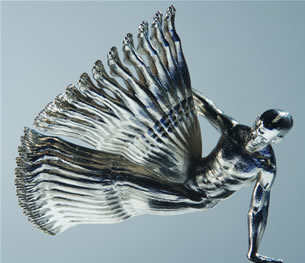 support, the object is put into a cuvette and filled up with a ceramic-plaster mixture. The cuvette is then put into an oven where the plastic object incinerates, leaving the remains of the ceramic-plaster. In a vacuum environment the cuvette is cast up with bronze. The vacuum environment enables you to cast objects with a very thin wall thickness of about 1,5 mm. Sometimes the bronze sculptures are coated with chrome or a patina with acids.
support, the object is put into a cuvette and filled up with a ceramic-plaster mixture. The cuvette is then put into an oven where the plastic object incinerates, leaving the remains of the ceramic-plaster. In a vacuum environment the cuvette is cast up with bronze. The vacuum environment enables you to cast objects with a very thin wall thickness of about 1,5 mm. Sometimes the bronze sculptures are coated with chrome or a patina with acids.
“At the moment I am also experimenting with real metal coating on the sculptures in polyamide, moreover we are trying out SLS in metal, i.e., real printing in metal, using titanium,” said Jansen.
Jansen continues to seek out movements that could be good candidates for sculptures.
Peter Jansen
Nijmegen,Netherlands
www.humanmotions.com/contact/contact.htm
www.peterjansen-art.com/transpositie/lineairetranspositie.htm
www.peterjansen-art.com/vananaarbeter/vananaarbeter.htm
Susan Smith is a contributing editor to Desktop Engineering magazine. You may send her e-mail addressed to [email protected].
Subscribe to our FREE magazine, FREE email newsletters or both!
Latest News
About the Author
DE’s editors contribute news and new product announcements to Digital Engineering.
Press releases may be sent to them via [email protected].






